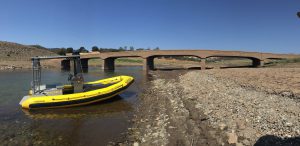Years of rumbling dump trucks and backhoes placing 2.75 million tons of rock “armor” along nearly a dozen miles of riverbank is an unpleasant thought for many who bike, jog, fish, bird-watch, golf, boat and swim along the lower American River Parkway.
But to demonstrate why officials currently are planning for some version of that scenario, Rick Johnson, the executive director of the Sacramento Area Flood Control Agency, points to a striking aerial photo taken after one of the worst deluges ever recorded in this region.
The photo was snapped in February 1986 after an extraordinary Pineapple Express storm filled reservoirs and rivers and pushed Sacramento’s flood infrastructure to its limits. The image shows an area near where the Capital City Freeway crosses the American River; it looks as if several giant bites had been taken out of the massive levee there.
Just on the other side of the levee sits the River Park neighborhood. If the rushing river – which at one point was surging with more than a million gallons per second – had eaten away just a few more feet of the barrier, Sacramento would have been awash in floodwater that would have rivaled what swamped New Orleans during Hurricane Katrina. Tens of thousands of homes could have been flooded.
But it wasn’t until the American River receded that anyone knew how close the city had come to disaster.
“The scary part is you couldn’t see (the damage to the levee). It was all underwater,” Johnson said. “We didn’t even know that was happening until after the water came down. They should have evacuated, quite frankly.”
Prompted by recent changes in state and federal flood control policy – largely in reaction to Katrina – local officials and the U.S. Army Corps of Engineers are in the initial phases of planning a $375 million project that would add a layer of rocky erosion protection along up to 11 miles of the lower American River.
The levees under consideration stretch along segments of the American River, starting where it meets the Sacramento River near downtown and ending upstream near the Butterfield neighborhood, which is about 4 miles east of the Watt Avenue bridge.
The project has presented flood control officials with a major challenge: How do they balance the need to armor the levees against erosion while at the same time protecting – or restoring after construction – the stream-side riparian habitat, as well as the trails and river access that make the lower American River Parkway a local treasure?
More at SacBee.com >>>

